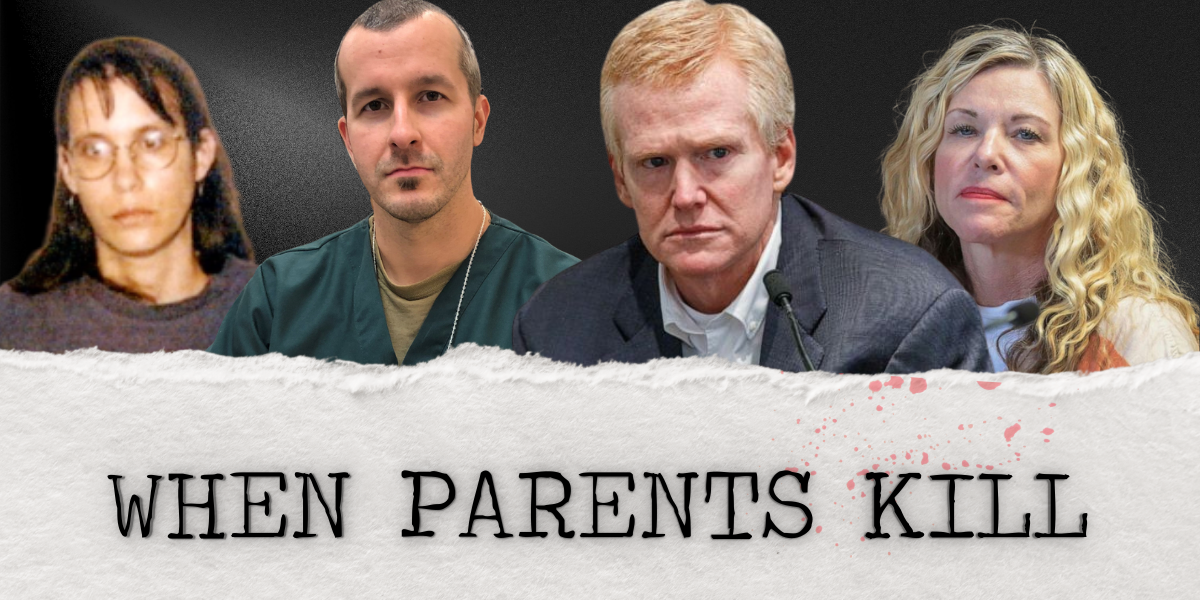By: Andrea Cipriano, MAFP
Note: This resource article discusses difficult topics, such as physical violence and violence against children. We encourage you to care for your well-being in identifying if this is content you can handle.

Mother. Father.
For many, these titles conjures warm feelings of compassion, trust, empathy, and support. Some people might see an image of their own parents in their mind’s eye — people who emulates these loving and protective characteristics.
A parent is often someone who has their child’s best interest at heart.
But what about a parent who is none of those things? Someone who is cold, cunning, manipulative, or even violent?
Historically, mothers who have killed their children have been considered heartless monsters. Similarly, fathers who kill their children are seen as failing to offer protection to those they should protect most.
Parents taking the lives of their own flesh and blood is a horrific subject matter. But with the current trending cases being discussed by the true crime community at large, education on this subject is critical.
Heartbreaking, Although Uncommon
Research tells us that filicide — when a parent kills their own child — is rare.
A 2014 Brown University study analyzing 32 years of filicide arrests found there are about 3,000 instances annually in the United States where a parent kills a child.
Of the 3,000 yearly instances, the United States Child Welfare Information Gateway says that 1,200-1,500 children are intentionally killed.
Frankly, any number is too high of a number.
What’s more, maternal filicide — when a mother kills their own child — is even more rare. To that end, each time a horrific crime like this occurs, it raises the most obvious and primal question…
How could this happen?
“Mothers don’t kill their children unless they are seriously disturbed,” Lanny Berman, executive director of the American Association of Suicidology in Washington, D.C., tells the Washington Post. “I think it gets attention because, one, it’s unfathomable, and two, it’s sensational and obviously the media reports on that.”
Texas Tech University’s Martha Smithey, a Criminologist who studies violence against children, has come to an even more disturbing conclusion. She says any parent who kills their own child is motivated by a mix of factors that doesn’t necessarily include mental illness.
“My work, and that of others, makes me realize that anyone is capable of hurting a child,” Smithey said. “Everyone has a recipe for ‘losing it’ and assaulting others. Most people manage to dance around the recipe and maintain control.”
The way she sees it, she says parents are often set up to fail by the high pressures put on them early on — especially mothers in neonaticide cases.
Neonaticide is the intentional killing of newborns within 24 hours after giving birth. The extent of these crimes is difficult to determine because so many go undetected, and there is no national data for these cases. A 2001 study estimates that “approximately 150-300 incidents of neonaticide occur each year in the US.” The researchers found the main motive for neonaticide offenses were “poverty, stigma, dowry, and disability.”
The FBI and the National Center for the Analysis of Violent Crime (NCAVC) have taken a particular interest in these types of cases, and have looked at the behavior of some of the mothers after disposing of the newborns.
Dr. Kristen R. Beyer, a Research Coordinator with the FBI and NCAVC, discovered that many of the 40 women in their 2008 study gave birth unassisted to infants of normal birth weight. The women then killed the newborn, disposed of their remains, cleaned up the crime scene, and remained undetected for as long as they could.
Beyer described the behavior of these women, writing in their finings: “Many of the offenders are then able to engage in routine activities immediately following the birth of the child, including attending classes, shopping, eating out, dancing, or returning to work.”
What’s even more interesting, Beyer found “very little evidence” that the women who engaged in neonaticide had mental or psychological disorders, and only a few showed some “bizarre behaviors” following the murders.
Could this seemingly lack of outward remorse be because the mothers had not yet bonded with the baby? They never dressed the infant, fed them, or allowed them the ability to live?
The Heartbreak of Filicide
For children under five, mothers and fathers are statistically equally responsible for committing murders. To that end, before becoming a killer, there is often a power imbalance in the profile.
“Male filicide perpetrators were more likely to use violence against intimate partners and children before the filicide, whereas female filicide perpetrators were more likely to be victims of violence and abuse,” Australian Magistrate and Coroner Teresa O’Sullivan has told ABC News.
 Of course, not all filicide cases are the result of outright violence and abuse.
Of course, not all filicide cases are the result of outright violence and abuse.
As discussed above, some filicide cases are associated with psychotic episodes or severe mood disorders suffered by a parent. These incidents are often perpetrated by women as part of postpartum depression or psychosis because of the rapid hormone cycling.
Take, for example, Andrea Yates, who confessed to drowning her five children in their bathtub on June 20, 2001.
Just over a year before she killed her children, Andrea was hospitalized after giving birth to her fourth child because Andrea was trying to overdose on medication. In spite of contrary advice from her treating psychiatrist, she and her husband went on to have their fifth child.
At that time, her postpartum depression escalated into postpartum psychosis, leading to her ending her babies’ lives because she felt that her children would burn in hell if she didn’t drown them.
Her mental state was so shattered that Andrea, now almost 60, remains in Kerrville State Hospital. She has now spent a third of her life institutionalized.
Some of the biggest red flags for filicide are being missed almost entirely.
Experts say the lack of awareness of these types of heinous crimes means that not enough work is being done to address them.
Research has previously shown filicides occur when a “cocktail” of factors come into play — namely mental illness, a relationship breakdown, inter-familial violence, and substance abuse.
Take Alex Murdaugh, for example.
Robert Alexander Murdaugh, the disgraced South Carolina legal tycoon, was found guilty of killing his wife, Margaret “Maggie” Murdaugh, 52, and son, Paul Murdaugh, 22.. The pair were found shot to death on the 1,770 acre Moselle Road property in Islandton, South Carolina in 2021. Maggie was shot five times in the back with a rife, while Paul was shot with two close-range shotgun blasts to his chest and back of his head. Both were found near their dog kennels.
Alex’s “cocktail” was his intense abuse of opioids, and his attempt to distract and delay investigations into his growing financial problems. That, coupled with double in his marriage, legal issues with Paul, and the presence of weapons on the property culminated into this family annihilation.
Other research has shown that if a parent dropped out of school at a young age, or had anger troubles combined with immaturity, that these were red flags associated with the killing of one’s child.
But many of those factors are difficult to spot.
Director of the Centre for Forensic Behavioural Science in Australia, James Ogloff, says filicide cases are some of the hardest to predict because, often, “there are no smoking guns.” In cases the Centre has studied, they’ve found neighbors and friends will report that these families are happy and warm… but miserable behind closed doors.
Perhaps the closest we are to identifying red flags for filicide comes from a 1969 study by Phillip Resnick. Resnick reviewed 131 cases of child murder and classified the apparent motives into five main categories that are still used today: altruistic, acutely psychotic, unwanted child, accidental, and spouse revenge.
Most alarmingly, Resnick writes that it’s up to the larger community — family, friends, neighbors, coworkers, and teachers — to look out for specific negative talk surrounding these topics.
While this is an unimaginable topic to discuss, the potential benefits of being educated mean this is a meaningful conversation to be had.
Andrea Cipriano is a Case Researcher and Content Specialist at Uncovered, where she writes for the twice-weekly true crime newsletter, The Citizen Detective. Andrea graduated with a Master of Arts in Forensic Psychology from John Jay College of Criminal Justice where she focused on researching and peeling back the criminal mind. Andrea believes that it’s never too late for justice.
